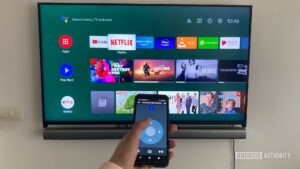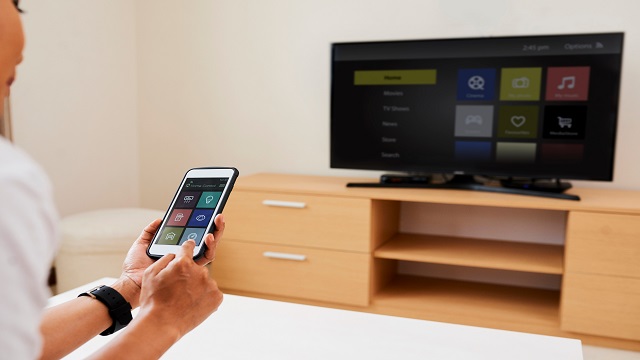How to Use Your Smartphone As a TV Remote
Use Your Smartphone As A TV Remote offer mobile apps that make it easy to pair them and access advanced controls. But what if you don’t have the right app or the remote is out of batteries?
Fortunately, most smartphones are capable of acting as a TV remote. Here’s how to do it.
In the age of technological convergence, the smartphone has evolved into a versatile device capable of handling various tasks. One such functionality is using your smartphone as a TV remote. This not only adds convenience to your home entertainment setup but also reduces the clutter of multiple remotes. In this guide, we’ll explore simple and effective methods to transform your smartphone into a smart and efficient TV remote.

-
Check Compatibility:
Before diving into the process, ensure that your TV and smartphone are compatible for remote control. Most modern smart TVs come with built-in features to connect with smartphones, such as Infrared (IR) or Wi-Fi. If your TV is not a smart TV, you may need additional hardware like an IR blaster or a device like Google Chromecast.
- Use Built-in Features:
a. Infrared (IR) Blaster: Some smartphones come equipped with an IR blaster, allowing them to transmit infrared signals just like a traditional remote. Check if your smartphone has this feature, and if so, download a compatible remote control app from your device’s app store. These apps often offer a user-friendly interface resembling a traditional remote control, making it easy to navigate and control your TV.
b. Wi-Fi Connectivity: Many smart TVs support Wi-Fi connectivity, enabling them to connect with smartphones over the same network. Ensure your TV and smartphone are connected to the same Wi-Fi network. Download a compatible remote control app from the app store, and follow the on-screen instructions to pair your devices. This method often provides additional features, such as a virtual keyboard for text input and voice commands.
-
Universal Remote Control Apps:
Several third-party apps serve as universal remote controls, compatible with a wide range of TVs. Apps like Peel Smart Remote, AnyMote Universal Remote, and Sure Universal Remote offer extensive databases of TV brands and models. Follow these steps:
a. Download and Install: Install the chosen app from your smartphone’s app store.
b. Setup Process: Follow the app’s setup process, which typically involves selecting your TV brand and model. Some apps may require additional steps, such as connecting via Wi-Fi or entering a code displayed on your TV screen.
c. Customization: Many universal remote apps allow you to customize the layout of the virtual remote according to your preferences. This includes arranging buttons, adding shortcuts, and creating macros for specific actions.
-
Smart TV Manufacturers’ Apps:
Most major TV manufacturers offer dedicated remote control apps for their smart TVs. Apps like Samsung SmartThings, LG TV Plus, and Sony TV Side View provide seamless integration with their respective TVs. Follow these steps:
a. Download the Manufacturer’s App: Visit your smartphone’s app store and download the official remote control app provided by your TV’s manufacturer.
b. Connect to Your TV: Ensure your smartphone is connected to the same Wi-Fi network as your smart TV. Open the app, and it should automatically detect and connect to your TV.
c. Enjoy Enhanced Features: Manufacturer-specific apps often come with additional features, such as screen mirroring, content sharing, and voice commands.
Connect Your Phone to Your TV
Many modern smartphones and TVs support wireless streaming technologies like screen mirroring, Miracast, and AirPlay. These connections allow you to enjoy photos, videos and more on a large display without needing a cable or a Wi-Fi connection. However, if you’re dealing with a weak or spotty Wi-Fi signal or are using your phone for gaming, it can be more effective to connect your device via a wired USB connection. This method can also help reduce lag from video games and other high-speed activities.
To connect your phone to a TV via USB, first make sure that your phone supports the connection. Most Android phones do, but you may need a special cable or adapter to get the job done right. The exact type of cable you’ll need depends on your device, but most of the time it will be a standard USB data cable that comes with your smartphone. You can then attach the USB end of the cable to your phone and the HDMI end of the adapter to your TV.
Next, you’ll need to enable the screen mirroring feature on your phone. This can vary by phone and TV brand, but is usually a matter of navigating to the appropriate settings or notification menu. Once you have the feature enabled, simply connect your phone to the TV and select the corresponding HDMI input on the TV to see your device’s display appear on the screen.
Download an App
If you have an Android smartphone, there are apps that will turn your phone into a TV remote. These apps will give you basic controls such as volume, channel and playback, plus some advanced features that you won’t get with a standard remote.
The app you choose depends on the type of smart TV you have, and what kind of media streaming you do. There are basic remote control apps, apps for specific streaming devices like Roku or Chromecast, and there are general streaming service apps.
You can also use your smartphone as a remote for non-smart TVs and projectors, but this will require a separate remote control app that has a virtual remote display. The remote display will have arrows that work like a remote and will show you the current status of the device, including which app is currently in use.
There used to be a dedicated Google TV remote app in the Google Play Store, but it’s now baked into the Google TV app (formerly known as Google Play Movies and TV). You’ll need to have the latest version of the app and your Android phone must be on the same Wi-Fi network to use it.
You can also add the Google TV app to your Home Screen for quick access or put it on your lock screen for even quicker access. You can then add shortcuts to launch apps, change channels and more. If you’re constantly losing your remote, try using an app such as Tile to help you find it. The app is simple to use, displays your current location on a map and can make your phone ring even when it’s in silent mode.
Set a PIN
For years, TV remotes have been a constant source of frustration for many people. Whether they’ve fallen down the back of the sofa or gotten lost under papers, finding one has been a pain. Now, with the right phone and an app, you can have instant access to your favorite shows without ever having to search for a remote.
The first thing you need to do is connect your smartphone and your TV to the same Wi-Fi network. You’ll also need a Bluetooth connection turned on. After that, open the Google TV app on your smartphone and select ’Connect TV’ from the bottom right corner of the screen. The app will then display a code that you need to enter on your TV. Once this is done, the app will appear as a remote control for your TV and you’ll be able to navigate it using the virtual keyboard.
If you want to use your phone as a TV remote with more functionality, try downloading Smartify or Sonymote. These apps give you more options, like colored buttons, playback controls and settings menus. They’re available on both Android and iOS devices and are free to download, though you may need to edit your Quick Settings shortcuts to see them. If you’re concerned about children accessing your TV, set up a PIN to prevent them from using the remote. You can find this on the TV’s home menu under Device Preferences – Security & Restricted Profile.
Set a Timer
You may need to set up your smartphone to control a non-smart TV with an app that can communicate with the device over a home network. The exact steps will vary depending on your make and model of phone, but the general process involves connecting the phone to a computer or television via USB and then enabling “media remote” or “remote keyboard” functionality in the smartphone/PC software. You might need to do this multiple times, as your phone will need to be connected to the same network as your TV for it to work.
If you have videos or photos on your phone that you want to show off on a big screen, the easiest way is by using the “screen mirroring” feature available on many smart TVs. This will allow you to stream video, music and pictures from your phone directly to the TV. The steps for this will vary between devices, but most modern phones and smart TVs support this feature.
For other TV-related tasks, you can use your phone as a remote by downloading an app that can connect to the device over a wireless connection. These apps can typically perform functions like changing channels, adjusting volume and more. They can also be much more convenient and easier to use than traditional remotes, which you are more likely to misplace or lose in the first place.
Conclusion:
Turning your smartphone into a TV remote is a straightforward process that enhances your home entertainment experience. Whether your smartphone supports IR, Wi-Fi, or relies on universal remote control apps, the convenience and versatility offered make it a worthwhile endeavor. By following these simple steps, you can declutter your living space and enjoy the benefits of a unified and smart home entertainment control system.


